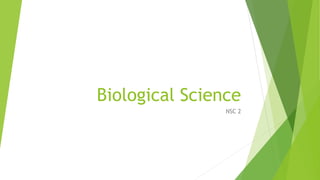
Biological science
- 3. Main Branches Natural Science Social Science Formal Science Applied Science
- 4. What is Science??? Science is the pursuit and application of knowledge and understanding of the natural and social world following a systematic methodology based on evidence.
- 5. Biology Bio means “life” and logos means “study” Biology- study of life or living matter and its forms, origin, growth, reproduction, structure and behavior
- 6. Branches of Biology Botany is the study of plants. Zoology is the study of animals. Anatomy is the study of internal structures of living things. Biochemistry is the use of chemistry in the study of living things. Ecology is the study of the relationships of living things to each other and to their environment. Pathology is the study if diseases, generally in animals. Phytopathology is the study of diseases in plants. Physiology is the study of normal functions of living things.
- 7. Taxonomy is the classification and naming of living things. Genetics is the science of heredity and the lifelong development of living things Embryology is the study of the formation and development of living things from fertilization to birth as independent organisms. Pharmacology is the study of the actions of chemicals on and in living things. Endocrinology is the study of hormones and their actions. Cytology is the study of cells. Histology is the study of tissues.
- 8. Bacteriology is the study of bacteria. Virology is the study of viruses. Mammalogy is the study of mammals. Ornithology is the study of birds. Herpetology is the study of reptiles and amphibians, Ichthyology is the study of fishes. Entomology is the study of insects. Helminthology is the study of worms. Microbiology is the study of microorganisms. Mycology is the study of fungi. Paleontology is the study of fossils.
- 9. What is Life??? A condition that shows distinction of plants and animals from inorganic matters.
- 10. Atom The basic structure of matter
- 11. Biomolecules Biomolecules are molecules that occur naturally in living organisms. Biomolecules include macromolecules like proteins, carbohydrates, lipids and nucleic acids.
- 12. Four Major Classes of Biomolecules • There are four major classes of biomolecules: • Carbohydrates • Lipids • Proteins • Nucleic acids
- 13. Functions of Biomolecules Carbohydrates provide the body with source of fuel and energy, it aids in proper functioning of our brain, heart and nervous, digestive and immune system. Deficiency of carbohydrates in the diet causes fatigue, poor mental function. Each protein in the body has specific functions, some proteins provide structural support, help in body movement, and also defense against germs and infections. Proteins can be antibodies, hormonal, enzymes and contractile proteins. Lipids, the primary purpose of lipids in body is energy storage. Structural membranes are composed of lipids which forms a barrier and controls flow of material in and out of the cell. Lipid hormones, like sterols, help in mediating communication between cells. Nucleic Acids are the DNA and RNA, they carry genetic information in the cell. They also help in synthesis of proteins, through the process of translation and transcription.
- 14. In 1665 Robert Hooke Hooke looked at the bark of a cork tree and observed its microscopic structure. In doing so, he discovered and named the cell – the building block of life. He thought the objects he had discovered looked like the individual rooms in a monastery, which were known as cells.
- 15. Animal cell All animals are multicellular. Human body contains trillions of cells. All animal cells are eukaryotic, they are surrounded by cell membrane and do not have a cell wall.
- 17. Plant cell Plant cell are eukaryotic cells, they are membrane bound organelles. They are surrounded by a rigid cell wall. Plant cells are similar to animal cells in being eukaryotic and they have similar cell organelles. Generally, plant cells are larger than animal cells and are mostly similar in size and are rectangular or cube shaped. plant cell contains a few distinctive features like a cell wall, large vacuole and plastids.
- 19. Plant Cell Animal Cell Cell Wall Cell wall made of cellulose is present in almost all cells. Cell wall is absent. Plastids Plastids like leucoplasts, chloroplast and chromoplasts are present. No plastids found. Chloroplasts Plants cells have chloroplasts to prepare their own food. Chloroplasts completely absent. Vacuoles Cell sap containing vacuoles are present. Vacuoles are usually absent or one or more small vacuoles are seen. Lysosomes Lysosomes not evident. Lysosomes occur in cytoplasm. Nucleus Due to the presence of the vacoule at the centre of the cell, nucleus may be located at the edge of the cell. Nucleus is usually located centrally. Golgi bodies Plant cells have many simpler units of golgi complex, called dictyosomes. Animal cells have a single highly elaborate golgi complex. Endoplasmic reticulum Present Present Ribosomes Present Present Mitochondria Present Present Centrioles Present only in lower plant forms. Present
